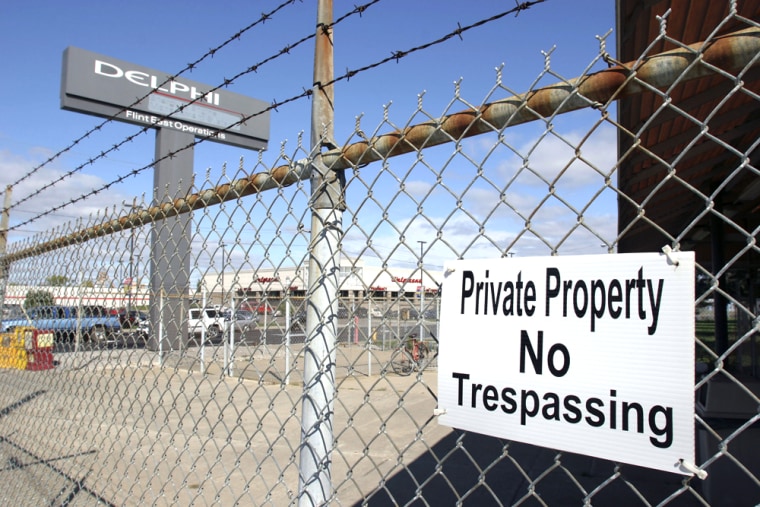First came the U.S. steel industry. More recently, money-losing airlines have landed themselves in bankruptcy court to cut labor costs. Now, Saturday's filing by auto parts maker Delphi signals that the U.S. auto industry has arrived at the same crossroads with its work force: agree to out-of-court concessions, or face the prospect of court-ordered cuts in wages, benefits and pensions.
Delphi, a $29 billion industrial giant,has been struggling to make a profit since General Motors spun off its parts subsidiary in 1999. Last year, Delphi lost $4.8 billion; it lost nearly $750 million in the first half of this year.
A tougher new bankruptcy law effective Oct. 17 may have accelerated Delphi’s move to seek refuge in federal court in Manhattan to reorganize its money-losing operations. Among other provisions, the new law makes it harder to pay bonuses to keep managers and imposes tighter deadlines on filers to either exit bankruptcy or liquidate faster.
But the forces that pushed Delphi into bankruptcy court have been building for years. As the auto industry has gone global, U.S. automakers — saddled with high-cost labor contracts negotiated in more prosperous times — now find themselves pitted against leaner overseas rivals.
Delphi's bankruptcy filing, which became more likely as the Oct. 17 deadline loomed, nonetheless sent shockwaves through the industry. The company’s management has said operations won’t be affected. And the complicated three-way talks between Delphi, the United Auto Workers and General Motors will continue. At stake is billions of dollars owed Delphi’s work force, including wages, benefits and pension payments — some of which GM agreed to take on when it spun off Delphi to fend for itself.
The most immediate impact will be on Delphi’s 185,000 workers. The company wants to cut wages to less than half of current levels and eliminate a "jobs bank" that gives full pay to 4,000 laid-off workers.
Delphi's retirees face similar cuts if the company follows the lead of steel companies and airlines that have successfully used the bankruptcy courts to offload their pension obligations to the federal Pension Benefit Guaranty Corporation, an agency set up in 1974 that is funded by contributions from premiums paid by companies. Once the agency takes over a pension plan, workers receive only part of their benefits.
The PBGC itself is on a rocky financial footing, in part because of chronic under-funding of older, so-called "defined benefit" pension plans in favor of pay-as-you-go 401(k) retirement savings plans, which don't leave employers with long-term obligations to pay retirees.
As of the start of this year, the PBGC was under funded by some $23 billion. A report last month by the General Accountability Office estimated that gap will swell to $87 billion over the next decade. If the PBGC continues to shoulder the cost of more failed pension plans dumped by ailing companies, those liabilities could hit $119 billion in 15 years and $142 billion within two decades, the GAO report said.
Congress has moved to address the issue, but a measure to fix the problem has stalled in the Senate. At issue is a provision that would raise premiums for companies whose financial condition have reduced their credit rating to “junk bond” levels.
That would further raise costs for GM and Ford, which have already been given “junk bond” ratings by Moody's Investors Service and Standard and Poor’s because of continued losses. Those sub-par ratings have already raised the companies' borrowing costs. (Fitch Ratings has cut GM to junk status but continues to keep an investment grade rating on Ford. S&P said recently it is reviewing the rating for the two biggest automakers and could downgrade them further early as mid-January.)
The impact of Delphi’s bankruptcy is also being felt further down the auto industry food chain. The part maker’s suppliers now face the prospect of tougher new terms at prices that may force some of them to close up shop. And Delphi’s customers — GM is still the largest — now face the prospect of higher parts costs, as Delphi works to cancel contracts negotiated at unprofitable prices.
No one suggests that bankruptcy filings by General Motors and Ford are imminent or even likely. Both companies have stockpiled billions of dollars in cash to weather another downturn that has become an inevitable part of the industry’s life cycle. But that cycle now appears to be broken.
Though the U.S. economy remains relatively healthy, GM posted a $1.2 billion loss in the second quarter — on top of a $1.1 billion first quarter loss, the worst in more than a decade. And the company’s market share has fallen to all-time lows, as buyers have switched to Toyota, Nissan and other rival Asian automakers.
Even before rising gasoline prices began to erode sales of highly profitable SUVs and light trucks, the American automotive industry faced an uphill battle to profitability.
Much the way newer, low-cost carriers have upended the economics of the airline industry, Detroit’s overseas rivals are forcing their older, higher-cost competitors to slash costs to stay competitive. U.S. automakers spend less money on steel, for example, than they do on health care benefits — a cost its Japanese and European rivals do not face because of national health care programs.
GM’s response has included plans to close plants and cut 25,000 American jobs by 2008. Those cuts will certainly reduce overall costs, but as the automaker shrinks, the cost of pension payments and retiree health benefits is spread over fewer cars, increasing the labor cost of each car, and making it even tougher to offer competitive prices against lower-cost Asian manufacturers.
